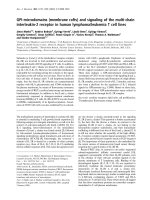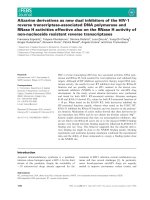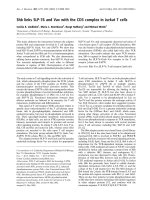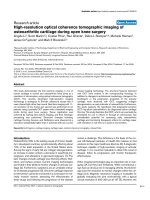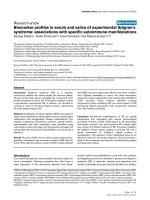Báo cáo y học: " Achondroplasia manifesting as enchondromatosis and ossification of the spinal ligaments: a case report" ppsx
Bạn đang xem bản rút gọn của tài liệu. Xem và tải ngay bản đầy đủ của tài liệu tại đây (585.91 KB, 4 trang )
BioMed Central
Page 1 of 4
(page number not for citation purposes)
Journal of Medical Case Reports
Open Access
Case report
Achondroplasia manifesting as enchondromatosis and ossification
of the spinal ligaments: a case report
Ali Al Kaissi*
1,2
, Rudolf Ganger
2
, Klaus Klaushofer
1
, Monika Rumpler
1
and
Franz Grill
2
Address:
1
Ludwig Boltzmann Institute of Osteology, Hanusch Hospital of WGKK and AUVA Trauma Centre Meidling, 4th Medical Department,
Hanusch Hospital, Vienna, Austria and
2
Orthopaedic Hospital of Speising, Paediatric Department, Vienna, Austria
Email: Ali Al Kaissi* - ; Rudolf Ganger - ; Klaus Klaushofer - ;
Monika Rumpler - ; Franz Grill -
* Corresponding author
Abstract
Introduction: A girl presented with achondroplasia manifested as mild knee pain associated with
stiffness of her back. A skeletal survey showed enchondroma-like metaphyseal dysplasia and
ossification of the spinal ligaments. Magnetic resonance imaging of the spine further clarified the
pathological composites.
Case presentation: A 7-year-old girl presented with the classical phenotypic features of
achondroplasia. Radiographic documentation showed the co-existence of metaphyseal
enchondromatosis and development of spinal bony ankylosis. Magnetic resonance imaging showed
extensive ossification of the anterior and posterior spinal ligaments. Additional features revealed
by magnetic resonance imaging included calcification of the peripheral vertebral bodies associated
with anterior end-plate irregularities.
Conclusion: Enchondromas are metabolically active and may continue to grow and evolve
throughout the patient's lifetime; thus, progressive calcification over a period of years is not
unusual. Ossification of the spinal ligaments has a specific site of predilection and often occurs in
combination with senile ankylosing vertebral hyperostosis. Nevertheless, ossification of the spinal
ligaments has been encountered in children with syndromic malformation complex. It is a
multifactorial disease in which complex genetic and environmental factors interact, potentially
leading to chronic pressure on the spinal cord and nerve roots with subsequent development of
myeloradiculopathy. Our patient presented with a combination of achondroplasia, enchondroma-
like metaphyseal dysplasia and calcification of the spinal ligaments. We suggest that the
development of heterotopic bone formation along the spinal ligaments had occurred through an
abnormal ossified enchondral mechanism. We postulate that ossification of the spinal ligaments and
metaphyseal enchondromatous changes are related to each other and represent impaired terminal
differentiation of chondrocytes in this particular case. Standard radiographic examination showed
spinal bony ankylosis only. The pathological composites of the vertebrae have been clarified using
scanning technology. Extensive spinal ligament ossification associated with calcification of the
peripheral vertebral bodies and anterior end-plate irregularities were notable. We report what
may be a novel spinal and extraspinal malformation complex in a girl with achondroplasia.
Published: 11 August 2008
Journal of Medical Case Reports 2008, 2:263 doi:10.1186/1752-1947-2-263
Received: 6 December 2007
Accepted: 11 August 2008
This article is available from: />© 2008 Al Kaissi et al; licensee BioMed Central Ltd.
This is an Open Access article distributed under the terms of the Creative Commons Attribution License ( />),
which permits unrestricted use, distribution, and reproduction in any medium, provided the original work is properly cited.
Journal of Medical Case Reports 2008, 2:263 />Page 2 of 4
(page number not for citation purposes)
Introduction
Achondroplasia is the most common form of skeletal dys-
plasia characterised by short limb dwarfism. It occurs as a
result of mutations in one copy of the fibroblast growth
factor receptor 3 gene (FGFR3). More than 97% of
patients have the same point mutation in FGFR3 and
more than 80% of these are new mutations. The muta-
tion, which causes an increase in FGFR3 function, affects
many tissues, most strikingly the cartilaginous growth
plate in the growing skeleton, leading to a variety of man-
ifestations and complications [1-3].
Enchondromas are common, usually benign, intra-
osseous cartilaginous tumours that develop in close prox-
imity to growth plate cartilage. Pathological fractures can
occur and when a joint is involved this may result in
shortening of a limb. The primary significant factors of
enchondromas are related to their complications [4-6].
Progressive vertebral fusion is a not uncommon radio-
graphic entity in children, often referred to as the Copen-
hagen syndrome [7]. We describe a previously unreported
combination of achondroplasia, metaphyseal enchondro-
matosis and ossification of the spinal ligaments.
Case presentation
A 7-year-old girl was brought to the orthopaedic depart-
ment because of mild knee and back pain associated with
restricted spine mobility. She was born full term following
an uneventful gestation. At birth her length was around
the 3rd percentile, whereas her occipito-frontal circumfer-
ence (OFC) and weight were around the 25th percentile.
She was clinically and radiographically diagnosed as hav-
ing achondroplasia. This was confirmed through the
detection of the common mutation of FGFR3 for achon-
droplasia. The parents were of normal height, healthy and
non-consanguineous. Clinical examination at the age of 7
years showed marked growth deficiency, -4 standard devi-
ations, and her OFC and weight were around the 50th per-
centile. Craniofacially the head appeared large with
frontal bossing, but with midfacial hypoplasia. The hands
were short and broad with fingers exhibiting a three-
pronged (trident) appearance. Movements of the thoraco-
lumbar spine were limited, but movements of the cervical
region were spared. No associated abnormalities were
detected on examination of the nervous system, eyes,
heart or abdomen. The results of full blood analysis,
erythrocyte sedimentation rate and C-reactive protein
were normal. Moreover, there were no laboratory data
suggestive of endocrinopathies, hypophosphatasia and/or
hypercalcaemia.
A skeletal survey and magnetic resonance imaging (MRI)
were undertaken at the age of 7 years (Figures 1, 2, 3, 4,
and 5). Achondroplasia is characterised by a long, narrow
trunk and short limbs, especially in a proximal segment.
It is the most common form of non-lethal skeletal dyspla-
sia and the most common type of short-limb dwarfism [1-
3] and is usually diagnosed at birth. Clinically the rhi-
zomelic limb shortening and the broad and prominent
forehead may not be striking, but radiologically the pelvis
Anteroposterior radiograph of the knee showing multiple small enchondroma-like metaphyseal dysplasiasFigure 2
Anteroposterior radiograph of the knee showing
multiple small enchondroma-like metaphyseal dys-
plasias. The distal femoral and the proximal tibial bones
show metaphyseal cupping with multiple enchondromatous
lesions and an abnormal metaphyseal trabecular pattern
associated with small round rings and arcs and dense foci is
as intended here within the metaphysis.
Anteroposterior radiograph of the pelvis showing rounded iliac bones, a horizontal acetabular roof and small sacroiliac notesFigure 1
Anteroposterior radiograph of the pelvis showing
rounded iliac bones, a horizontal acetabular roof and
small sacroiliac notes. Coxa vara with defective modelling
of the femoral necks associated with metaphyseal dysplasia
with no trace of enchondromatous lesions.
Journal of Medical Case Reports 2008, 2:263 />Page 3 of 4
(page number not for citation purposes)
is clearly abnormal. The complications of achondroplasia
involve many organ systems, but in most instances they
are consequences of abnormal linear bone growth. About
10% of patients have tibial bowing by the age of 5 years
which progresses through childhood, affecting 42% of
adult patients. In adulthood and postadulthood periods
the spinal canal size decreases with age relative to the size
of the spinal cord, leading to lumbar spinal canal stenosis.
One-third of patients with achondroplasia develop spinal
stenosis requiring surgical intervention. However, this
condition rarely develops before the age of 15 years [1-
3,8]. MRI has been performed on a number of children
with achondroplasia in order to study the aetiology
behind the development of spinal canal stenosis [9]. Spi-
nal ligaments were not included.
Enchondromatosis is a common bony dysplasia with a
variable pattern of bony involvement. The well-differenti-
ated forms of enchondromatosis are Ollier disease, Maf-
fucci syndrome, metachondromatosis, spondyloenchon-
dromatosis, dysspondyloenchondromatosis and geno-
chondromatosis I and II [2,3].
Unlike other types of enchondromatosis, metaphyseal
enchondromatosis is characterised by extensive develop-
ment of enchondromas within the epiphysis before clo-
sure of the growth plate [2,3,10,11]. Numakura et al. [11]
reported the cases of three boys presenting with achon-
droplasia and metaphyseal enchondromatosis.
Nizankowska-Blaz and Kozlowski [10] reported the case
of a girl with achondroplasia with knee pain secondary to
metaphyseal enchondromatosis. Scanning techniques
were not used in these cases, and spinal involvement was
not seen. Frydman et al. [5] described the development of
quadriparesis in connection with spondyloenchondrod-
ysplasia. Spinal scanning was not used. Al Kaissi et al. [6]
described progressive vertebral fusion in connection with
spinal enchondromatosis in a girl without achondropla-
sia. The patient's father had been a patient at the rheuma-
tology department because of thoracic spine bony
ankylosis, even though all of his rheumatological tests
had proven negative. They suggested that this father and
daughter pair have a possibly distinctive form of spinal
enchondromatosis associated with progressive ossifica-
tion of the spinal ligaments.
Conclusion
In summary, given the unusual range of malformation
complexes in our present patient, it appears that standard
radiographic documentation may be insufficient to fur-
ther understand the composites of the spinal pathological
mechanism. A referral to scanning technology is therefore
recommended.
Lateral thoracic spine radiogram showing extensive ossifica-tion of the anterior (white arrow) and the posterior longitu-dinal ligaments with the development of long bony ankylosis with no skip areas along the posterior aspect (black arrow)Figure 4
Lateral thoracic spine radiogram showing extensive
ossification of the anterior (white arrow) and the
posterior longitudinal ligaments with the develop-
ment of long bony ankylosis with no skip areas along
the posterior aspect (black arrow).
Anteroposterior radiograph of the ankle joint showing enchondromas with the appearance of linear lucenciesFigure 3
Anteroposterior radiograph of the ankle joint show-
ing enchondromas with the appearance of linear
lucencies. The chondrocytes appear to line up in a vertical
orientation along the epimetaphyseal components associated
with sclerosis of the articular surface.
Publish with BioMed Central and every
scientist can read your work free of charge
"BioMed Central will be the most significant development for
disseminating the results of biomedical research in our lifetime."
Sir Paul Nurse, Cancer Research UK
Your research papers will be:
available free of charge to the entire biomedical community
peer reviewed and published immediately upon acceptance
cited in PubMed and archived on PubMed Central
yours — you keep the copyright
Submit your manuscript here:
/>BioMedcentral
Journal of Medical Case Reports 2008, 2:263 />Page 4 of 4
(page number not for citation purposes)
Abbreviations
FGFR3: Fibroblast growth factor receptor 3; MRI: Mag-
netic resonance imaging; OFC: Occipito-frontal circum-
ference.
Competing interests
The authors declare that they have no competing interests.
Authors' contributions
AAK was responsible for a) writing the MS, b) data analy-
sis, and c) conception and design, KK and MR Participated
in conception and design, FG Participated in data analy-
sis.
Consent
Written informed consent was obtained from the patient's
next-of-kin for publication of this case report and accom-
panying images. A copy of the written consent is available
for review by the Editor-in-Chief of this journal.
References
1. Chitayat D, Fernandez B, Gardner A, Moore L, Glance P, Dunn M,
Chun K, Sgro M, Ray P, Allingham-Hawkins D: Compound hetero-
zygosity for the achondroplasia-hypochondroplasia FGFR3
mutations: prenatal diagnosis and postnatal outcome. Am J
Med Genet 1999, 84:401-405.
2. Spranger JW, Brill PW, Poznanski A: Bone Dysplasias. An Atlas of
Genetic Disorders of Skeletal Development New York: Oxford Univer-
sity Press; 2002.
3. Maroteaux P, Le Merrer M: Maladies osseuses de l'enfant 4th edition.
Paris: Medicine-Science, Flammarion; 2002:266-268.
4. Unni KK: Cartilaginous lesions of bone. J Orthop Sci 2001,
6:457-472.
5. Frydman M, Bar-Ziv J, Preminger-Shapiro R, Brezner A, Brand N, Ben-
Ami T, Lachman RS, Gruber HE, Rimoin DL: Possible heterogene-
ity in spondyloenchondrodysplasia: quadriparesis, basal gan-
glia calcifications, and chondrocyte inclusions. Am J Med Genet
1990, 36:279-284.
6. Al Kaissi A, Klaushofer K, Grill F: Progressive vertebral fusion in
a girl with spinal enchondromatosis. European J Radiol Extra
2007, 63:125-129.
7. Anderson J, Rostgaard-Christensen E: Progressive non-infectious
anterior vertebral fusion. J Bone Joint Surg Br 1991, 73:859-862.
8. Gordon N: The neurological complications of achondroplasia.
Brain Dev 2000, 22:3-7.
9. Jeong ST, Song HR, Keny SM, Telang SS, Suh SW, Hong SJ: MRI study
of the lumbar spine in achondroplasia. J Bone Joint Surg Br 2006,
88:1192-1196.
10. Nitzankowska-Blaz T, Kozlowski K: Achondroplasia and enchon-
dromatosis in a female child. Skeletal Radiol 2003, 32(7):432-4.
11. Numakura C, Kobayashi H, Hasegawa Y, Adachi M, Hwa Kim O,
Nishimura G: Achondroplasia and enchondromatosis: report
of three boys. Skeletal Radiol 2007, 36:S29-S33.
Magnetic resonance imaging of the lower thoracic spine with sagittal T2 fast spin echo sequences showing the ossified anterior longitudinal ligament with subsequent anterior ver-tebral hyperostosis and bridging (arrows)Figure 5
Magnetic resonance imaging of the lower thoracic
spine with sagittal T2 fast spin echo sequences show-
ing the ossified anterior longitudinal ligament with
subsequent anterior vertebral hyperostosis and
bridging (arrows). In addition there was involvement of
the posterior longitudinal ligament. Peripheral sclerotic bor-
ders associated with anterior end plate irregularities have
outlined the overall vertebral bodies.




